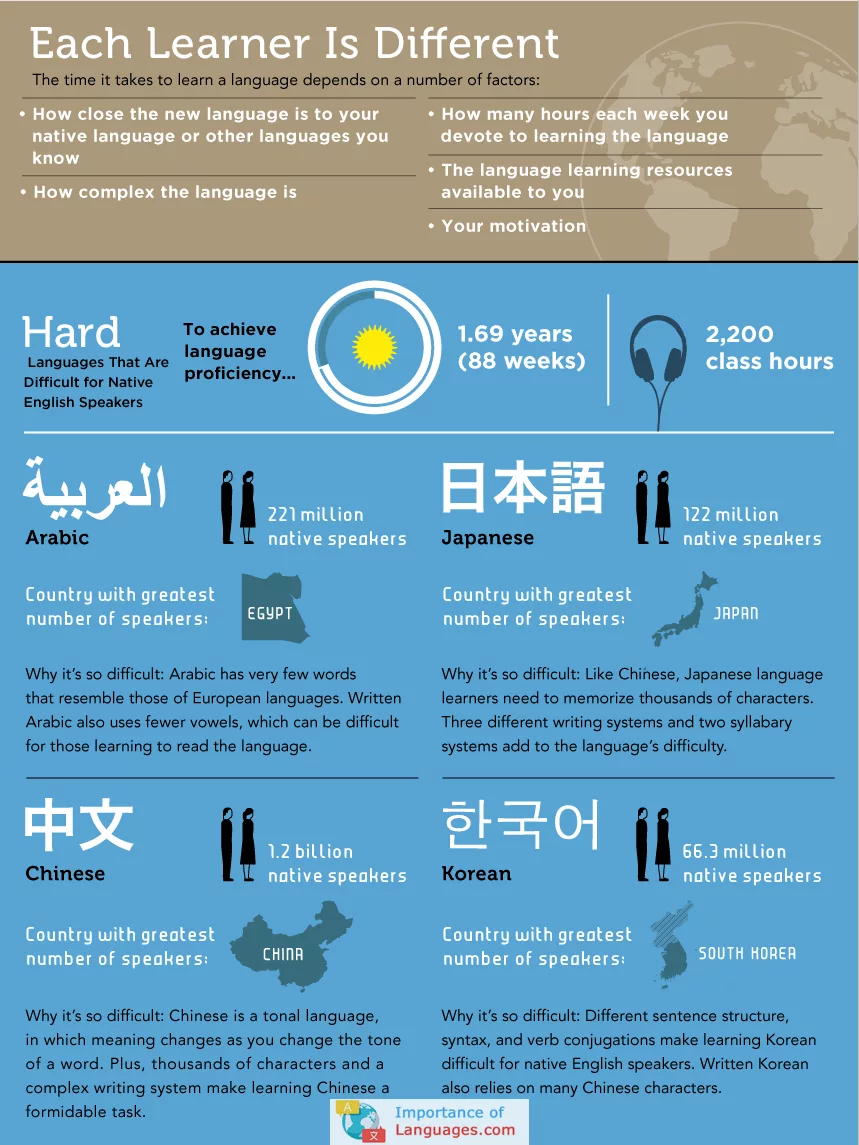Contents
Top 4 Hardest Languages to Learn
- Arabic Language
Why it’s so difficult: Arabic has very few words that resemble those Of European languages. Written Arabic also Uses fewer vowels, which can be difficult for those learning to read the language.
Why it’s so difficult: Like Chinese, Japanese language learners need to memorize thousands Of characters. Three different writing systems and two syllabary systems add to the language’s difficulty.
- Chinese Language
Why it’s so difficult: Chinese is a tonal language, in which meaning changes as you change the tone of a word. Plus, thousands of characters and a complex writing system make learning Chinese
Why it’s so difficult: Different sentence structure, syntax, and verb conjugations make learning Korean difficult for native English speakers. Written Korean has many Chinese characters.
The time it takes to learn a Hard language depends on a number of factors:
- How close the new language is to your native language or other languages you know
- How complex the language is Hard To achieve language
- How many hours each week you devote to learning the language
Hardest Language Infographic

What is the best way to learn a Hard Second language?
The best way to learn a second language is the same way we all learned our native language.
We learned it through visual recognition of objects and by simply learning how to put those object words together with other linking words to make sentences. And all that with no grammar rules or drills. Obviously, we don’t have the ability and the free time of our youth because if we did, we could learn a new language the same way we learned our native language as a child. So, what can we do now?
1. Natural Learning Approach
Let’s imagine a computer program and let’s call it the Natural Learning Approach. Imagine if it could use thousands of real-life images, written text and voices of native speakers. It would offer you instructions in Listening Comprehension, Reading, Speaking and Writing to teach you like a native learner. Previews, exercises and tests accompany every lesson with automated tutorials throughout the program.
Natural Learning Approach works by simulating the natural language learning process we all experienced as children. Systematic structure teaches vocabulary and grammar naturally, without memorization’s, lists and drills. Each lesson would tap into your intuitive ability to connect words and meanings instinctively. You learn to speak, read and write the new language progressively, quickly, naturally and easily. Our imaginary Natural Learning Approach program would reproduce the learning curve that we went through as a child when acquiring our own native language.
With instruction exclusively in the target language, you start thinking in the new language from the very first lesson. The association of pictures to native speakers’ voice and texts would allow you to master basic vocabulary quickly. And this, in turn, acts as a foundation on which to build words, phrases, sentences, and grammatical structures, still in the target language only. Within each lesson, you would choose from a variety of different activities that concentrate on listening comprehension, reading comprehension, speaking or writing.
2. Listening Languages comprehension
Natural Learning Approach teaches you to link speech directly with meaning. Match the spoken phrase and the image correctly and the meaning is clear. No translation or memorization. The words have meaning. The image has a name.
3. Reading Languages comprehension
Reading comprehension parallels the comprehension of speech. Natural Learning Approach develops reading skills by presenting written text without spoken-language support. Match words to image and the computer verify the meaning.
4. Speaking Languages
Speaking a new language is the learner’s most rewarding challenge. Natural Learning Approach Speech Recognition records your voice and plays it back for comparison with the voice of the native speaker. A graded meter would quickly assess your proficiency and a voiceprint analyzes your pronunciation in detail.
5. Writing Languages
Dictation uses the computer to check your written work for accuracy. Click on the picture. Write what you hear. Natural Learning Approach program would indicate errors and would allow you to correct your work before you proceed.
Wouldn’t this just be the best way to learn a language?

Natural Learning Approach
I really do RESPECT the American efforts, like yours now.!!!
Thanks you so much for your insights and offerings for others to use the work you’ve provided tho help others at becoming enthousiastic in their process of discovering the most beautiful things in live, whatever our age.
i really do thank you for all the work you’ve done and for you offering others, like me, to profit at any age from your GREAT contribution toward a great, cohesive world of people!!!.
I will stay focussed to learn other languages etc….. for the sake of world peace!
Thank you so much!!!
Roy.
R.K. NCT
(a Surinamer in Leiden, Holland)
Defining one language as the most difficult to learn in the world is a tricky concept. The difficulty of learning a language is relative to the learner’s native tongue (or tongues), as well as to any other languages that they may already have learned. We’ve enumerated 18 hardest languages to learn which you may find helpful: https://www.tomedes.com/translator-hub/hardest-languages-to-learn